Meals made in a clay pot are very easy to prepare. By enclosing your meal in a porous clay container that has been soaked in water, you ensure that the food’s natural juices, as well as all of the vitamins and minerals, are retained.
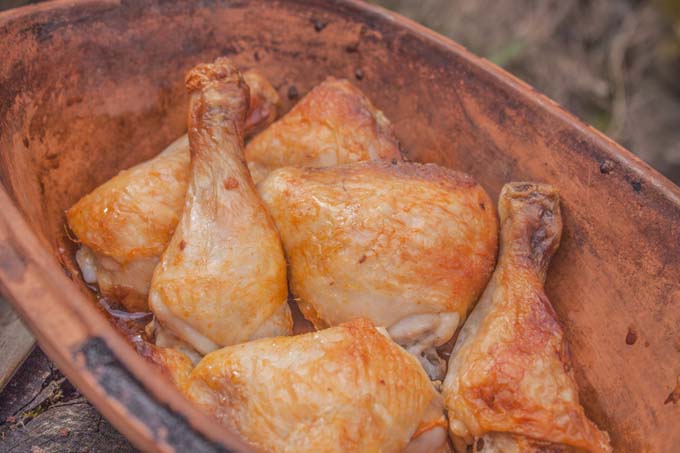
As the earthen container heats up over the fire, the retained water will turn to steam, which will keep your ingredients tender and flavorful.
Types of Earthen Cookware
You can find clay pots in virtually any market throughout the world. They come in many shapes and sizes, each with their own purpose.
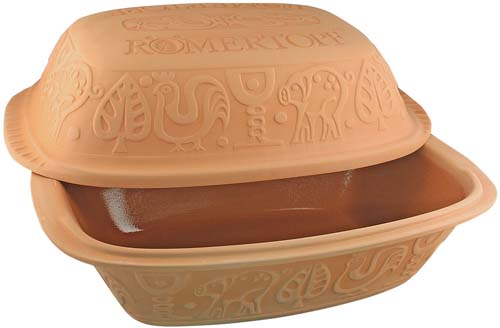
A Large Romertopf Glazed Clay Cooker available from Amazon.
The most common unglazed pots are made by Romertopf. These baking dishes are suitable for cooking all types of meats, fish, vegetables, and fruits. The classic version of this baking dish is rectangular in shape with a domed lid.
You can also find these dishes in an oval shape, which can accommodate an entire fish. Clay cookware designed for preparing fish usually features a glazed bottom, to prevent a lingering fishy smell. Although the lids are made to have a snug fit, there is a narrow gap where steam can escape.
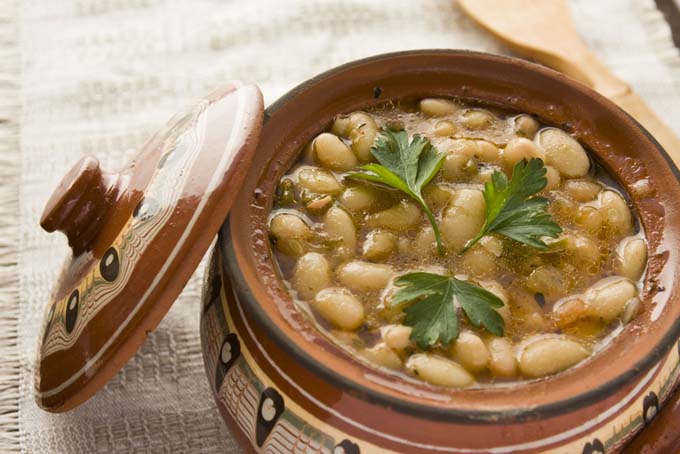
Bean pots are deep round vessels with domed lids. Some may feature handles for easier lifting. These are useful for slow cooking dried beans, soups, and stews.
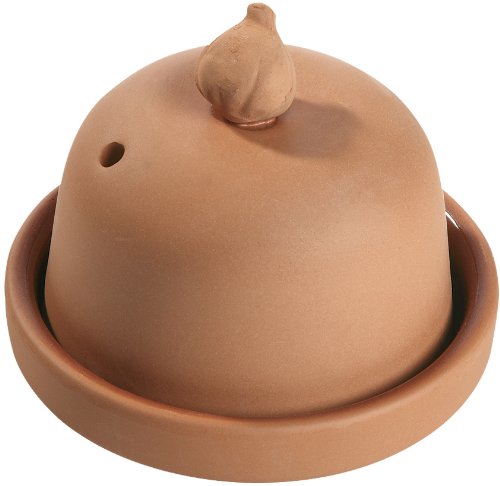
A Romertopf Glazed Garlic Roaster available on Amazon
Garlic and onion bakers are smaller baking dishes made of terracotta. They have high domed lids. These products are used primarily for baking garlic or onions. The onion bakers are slightly larger than the garlic bakers, in order to accommodate multiple medium-sized onions or wedges.
A chicken brick is a larger unglazed dish with a high domed lid. The largest ones can hold an entire chicken or duck, but this vessel can also be used to cook any large piece of meat. Smaller chicken bricks can be used for smaller portions.
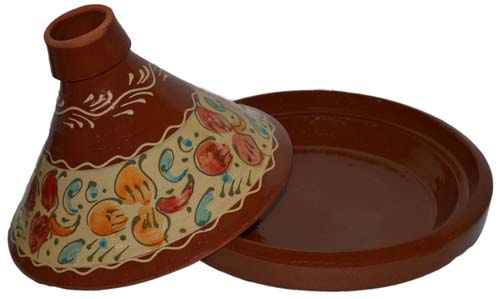
“Moroccan Wave” Cooking Tagine as found on Amazon
A tagine is a round North African pot used for cooking. It has a large shallow base and a tall lid that’s shaped like a cone with a hole at the top. The food is placed in the base. Steam rises and becomes trapped in the lid as the food cooks, keeping it moist.
A large variety of glazed ovenproof cookware is available. These dishes can be placed directly in a hot oven, and they do not need to be soaked beforehand. Unlike their unglazed counterparts, they will not absorb strong flavors or aromas.
With the proper care, earthen cookware can last for many years.
Preparing Your Clay Pots
Before you use your clay pot for the first time, be sure to clean it thoroughly. Brush out the inside to release any loose clay particles, then rinse and drain your new baking dish. Unglazed pots must be soaked in cold water for twenty minutes before each use.
If this is your first time using a dish, soak for an additional ten minutes. The water retained in the clay provides the moisture necessary for cooking. Fill your sink with cold water and place the bowl and lid inside, and make sure the entire pot and lid are submerged.
Partially glazed earthen pots should be cared for in the same manner. The glazed portion does not require soaking, but make sure the unglazed part is submerged for at least twenty minutes.
Cooking With Your Earthenware
For the most part, earthen containers should only be used inside an oven. Unglazed cookware cannot take sudden temperature changes, so stovetop cooking is out of the question. Always place your vessel in a cold oven to start, preferably on the bottom rack to make sure the heat can adequately circulate around it.
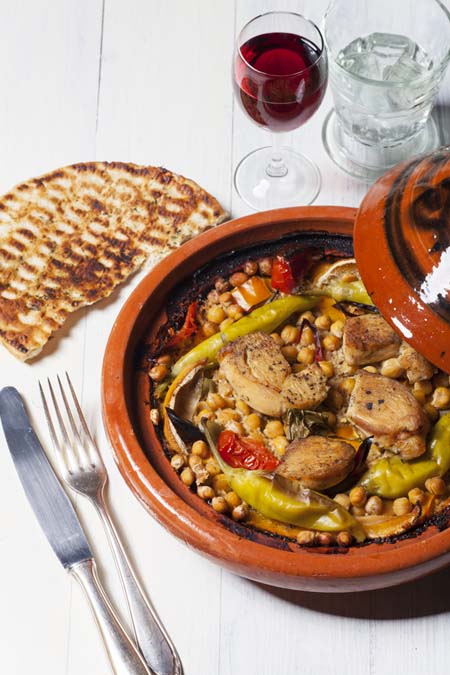
Add your ingredients and heat gradually. Your pot may crack if it experiences a sudden change in temperature.
Some recipes may require you to brown your meat before adding it to your recipe. If this is the case, allow the meat to cool a little before placing it in with the other ingredients.
Never add boiling water or other hot liquids to a cold earthen vessel. You may add these hot liquids while your dish is cooking.
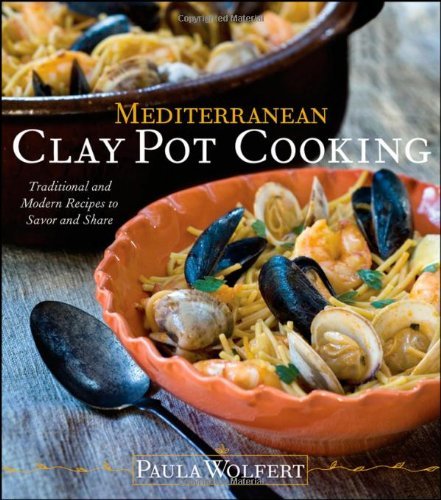
Foodal Recommends “Mediterranean Clay Pot Cooking: Traditional and Modern Recipes to Savor and Share”
Clay pots may also be used for baking cakes and breads. You should have separate baking dishes if you plan to make both sweet and savory recipes.
Wash your vessel with hot water immediately after use. Drain and allow to air dry on a kitchen towel or paper towel on the countertop. Do not put an earthen container away until you are sure that it is thoroughly dried. Store it in a dry part of your kitchen.
About Jennifer Swartvagher
Jennifer is an experienced journalist and author. Her work has been featured on TODAY Parents, The New York Times Blog, BlogHer, Scary Mommy, and scores of other parenting and cooking publications.

I have seen tagines in local specialty stores, but never had any idea what they were used for; now I know! This article is greatly informative. I would really like to try out clay pot cooking, the chicken in the top pictures looks absolutely delicious!
I have never heard of these but I want one. I like that they last a long time. I also like that some will not hold fish smells. I need some new cookware and these seem like they will stand up against rust. I am looking for a good pot that does not rust.
Clay pots? Oh yes, these kind of pots go way back, don’t they? I like the concept about them and how they can retain the natural juices and healthy minerals of the food you have in them. It sounds like they could be much more beneficial than regular pots minus the fact that you’d have to keep them very clean and free of any potential rust and avoid possibly breaking them easier.
I bought one ten years back and it is how I prefer to cook my chicken. It comes out perfectly. I found that my bread pudding also comes out much better when I use this pot. Surprisingly I have not done beans in them so I look forward to trying them.
Now this is a cooking method that I have yet to try! Haven’t ever even thought of buying clay pots for cooking but I’m very interested in what differences in texture and taste it can bring to the food. I will definitely be going out and pick myself up some earthenware to try this out. Thanks for sparking my interest!
Oooo, I like this and I have not heard of this either. Sort of like the crockpot but different. Will have to try this after I figure out what to make. I hadn’t thought about how something like this would keep the nutrients in either. Ok, so this is very interesting placing it in the oven when it is cold and slowly heating it up. The food is going to be outrageous this way I think. Slow and gradual heating will make the taste so incredible. This is what happens with the crock pot, but this seems like a much better method.
Bean pots are very popular back home, but I have never actually used one. I do have a few pieces of clay kitchenware for specific purposes, such as tarts, but none for multipurpose cooking. I do like the look of them and idea of using this type of cooking vessel.
I have never seen someone cook in clay pots before. If I ever get the chance to, I may buy some clay pots for beans or something. What type of clay is used for cooking pots?
I use mainly the aluminium ware. I see clay pots but have never taken time to buy them or even have the thought of using them. Maybe i should try soon. The problem is that i see them as old fashioned since they were mainly used by people from the past in my country.
Never used clay pots but this article may very well inclined me to do so. I heard a lot of good things about them and how the heat disipation is much better but I never went through with the decision. Better later than never I guess!
Well I’ve never tried using a clay pot to cook with. I don’t even think I have one to begin with. I’m kind of scared that it will break in the over though.
As long as you follow the proper care recommendations, your clay pot should last through the years. The most important would be to take care to avoid extreme temperature changes. For example, never take a clay pot from the refrigerator and place it into a hot oven.
Actually I own one of those but I’ve never used it and it’s been taking dust in my kitchen cabinet. I’ve always been curious about different cooking methods and this sounds like an interesting one. I like that the meat retains all of its juices! Now I need to try it out, I’ll make sure to follow your tips, I don’t want to crack or break it. I’ll buy the recipe book since I’m unfamiliar with those pots, it can help me experimenting with mine! When I’ll have a bit of confidence with it, I think I’ll get the bean pot and the Moroccan Wave, they look beautiful!
Thank you for the interesting read!
Clay pots are awesome! They are especially good for keeping food warm for long periods of time even when they’re off the stove, when I used one for the the first time, I was wondering why my tongue kept burning as I was digging into my first batch of potato meat stew, they have amazing heat retaining capabilities. I need to get back to using mine (a japanese version).
They’re very good for noodles or if your family is too distracted to finish dinner before it cools.
Clay pots are really common dishes in my country, especially in little towns. They actually bring me a lot of memories about picnics that sometimes we do on summer and winter with my family, and it’s kind of weird, but in my opinion food tastes better when it’s cooked on them, they give it a homemade kind of taste that’s just unique, and also, my grandpa used to keep water on them and it was always fresh, without mentioning that they are really cheap, what can be better than that? 🙂
Can I put my clay pot that is glazed inside in the oven?
These posts are old, so I’m not sure if anyone will see this. I bought a wonderful Pomeira pig roasting dish yesterday and now I don’t know what to do with it. The bottom has four legs and the pig’s head and tail, and is about 3 inches deep with 6 1″ holes evenly spaced around horizontally. I know this part is to hold ashes and coals. The middle piece is a fairly shallow and that is where the meat, veggies or fish goes. I believe that piece needs to be soaked, but I am getting different opinions. One store said to oil the pan and heat in the oven for 30 minutes before using. Others said to soak in water. The third part is the lid. My question: How do I use the charcoal bottom? How hot is it supposed to get? If terra cotta can’t take rapid change in heat, how can I start a fire in it without it cracking? How long do I cook meat, chicken, or fish in the middle pan? Will the wonderful aromas of wood or speciality charcoal infuse the meat? Help! I’m scared of my pig!!!
Apply a little science: start a fire in the clay underbasin and add coals. When you have coals that emit minimal smoke, place the overlying pan on top which has oil and food stuffs. Over time, heat transfers from the coals through the upper tray that holds the food, all materials heat up, and commence cooking. Stir with a wooden spoon. The coals will likely die out over 30 minutes, so keep the size of meat pieces small to ensure proper cooking. I also discovered something cool lately which I plan to buy. It is called the “kazan.” It is a cast-iron pot designed to cook over a fire and is traditionally used in Kazakhstan and surrounding countries. Basically, people put food in this pot that sits over a fire and can cook some amazing-looking dishes over the fire. Dishes that include a lot of rice, vegetables, and anything you can imagine. Good luck with your cooking.
I just purchased a used terra cotta pot. The inside of the lid and interior are glazed but not the outside. Do I still need to season the unglazed areas and does it require soaking? Sure would appreicate a reply. Looking forward to using it. Tks ????
Partially unglazed pots should always be soaked before use, but unglazed portions do not require seasoning if they are on the outside of the pot, as long as you will be using your new cookware in the oven. Clay cookware intended for use on the stovetop is a little different, and seasoning is required to improve durability and prevent cracking – but keep in mind that the majority of cookware in this category is not intended for use on a direct heat source. Wash by hand with warm water and a brush, and avoid using soap since it can be absorbed into the clay. Happy cooking, Melanie! Let us know what you make!
Allison, you sound knowledgeable, so maybe you can help me. I’ve been wanting clay cookware, finally found a couple of unglazed lidded pots locally and felt like they were an answer to prayer. But now I’m scared to use them!
I soaked them for 3 days, 1 day in water only, and 2 days in rice water. Now what to do? Online videos say to oil the pots but I want to avoid oil. I’m fine with pre-soaking the pots each time I want to cook if that eliminates the need to cure them with oil.
Is pre-soaking, and no oiling the pots, cooking on a hotplate with diffuser, a viable option?
Cooking in clay can be tricky since this is a sensitive material, and these types of pots will often have a shorter life than metal cookware, but you don’t need to be scared!
Most of my experience is with glazed clay, which is a bit more durable than unglazed pottery. Curing with oil is recommended to prevent cracking and to protect the interior surface of unglazed clay pots. I understand that you might want to avoid added oil in your cooking, or maybe you’re hoping to reap the benefits of your food coming into direct contact with the clay? The oil actually serves a different purpose here. Soaking in water helps to add moisture while you are cooking, whereas coating unglazed clay pots with oil is a key part of the curing process- rather than coating with oil that then comes off on your food, the oil actually helps to coat and protect the interior surface of the pot, similar to what you might do with cast iron.
After soaking and then drying your pots with a towel, coat them with a thin layer of cooking oil and then refill them about 3/4 of the way with water. Replace the lids. To cure, place them on the stove or your chosen heating element on top of a diffuser, or preferably in a cold oven, and heat (350°F max) for a few hours, then turn off the heat and allow them to cool completely. Extreme heat changes can crack clay, so you always want to remember to heat them gradually. Using a diffuser is recommended rather than making direct contact with any type of heating element, and you should thoroughly dry your pots on the outside before placing them on a heating element, or this may introduce cracks as well.
I haven’t heard of soaking in rice water, and recommendations in terms of soak time can vary. Soaking is typically done for a few hours at most, as far as I know, but I have also seen recommendations to do this for up to 12 hours. I suppose it could depend on the size of the pot, what you plan to cook in it, and the type of heating element that you plan to use. Pots and lids should be soaked each time you use them, for about 15 minutes before you cook. Then you can dry them and cook in them. Be sure to clean them by hand with hot water and salt or baking soda instead of soap, since the pores in the clay will absorb the soap.
When you say you found them locally- was this from a gift shop, or directly from a local artisan? Perhaps you could contact the seller/maker directly for additional tips and suggestions. Hope this helps!
These clay pot ‘ovens’ are wonderful – especially for roasting chickens along with vegetables – retains all the moisture even if overcooked and falling off the bones! It retains the flavours.
So clean to use. You tip off the excess liquid which accumulates and can chill it to remove the layer of animal fat which will set on the top and then use later for stock or gravies etc.
We’ve been married 43 years and our second one has just developed a crack on the lid.
First thing my husband said – we MUST get another one.
Cleaning them with brush in hot water is all that is necessary and yes make sure they are dry before putting in cupboard. Pre-soaking is key. Personally I’d never put one on top of cooktop only within an oven.
Yes into cold oven which is set to VERY HIGH temp – NO oiling or extra liquids required!
Search for some recipes – my two clay ovens have both been made in Germany and are the rectangular shape with dome lids. Very versatile as will retain heat and do long slow cook after your powered oven has been turned off – without the contents drying out.
Soak for sure. I don’t season any areas. I have used mine for at least 15 years, never had any issue. I soak and never store foods in the refrigerator in this baking pot.
I have a Romanian clay pot that is glazed in the outside and I made already stuffed cabbage in that pot but the liquids are sipping a little through the exterior of the pot. Is that normal? Do I have to soak the inside since is glazed only outside? When I got it the lady told me that it doesn’t have to be soaked. I got it from a street market in Romania.
I’ve just bought an Italian terracotta dish, the lid is unglazed and the bottom is glazed so do I soak the unglazed lid for 20 mins in cold water and then do I the same to the base anyway and then of course put dish in a COLD oven?
You are correct Sasha – because the unglazed portions are porous, the lid should be soaked prior to use. Start with a cold heating element and heat the earthenware up slowly, to prevent cracking.
I purchased a beautiful unglazed clay pot in a ceramics village in Vietnam. I have been terrified of ruining it, although I know it’s made for cooking. I’m going to season it per your instruction above with some canola oil. My big concern is understanding the cooking times. Putting it into a cold oven and then bringing it up to temp seems like it would extend cook time, but I’ve also read that it cooks faster. What is the best way to understand cooking times for different dishes?
Starting with recipes designed for this type of cookware is certainly recommended. Otherwise, you will need to plan to make adjustment. The time spent brining the vessel up to temperature is not included as a portion of the total cook time (unless a recipe specifically states this).
I have a vintage The Emperor Kwong-josh Steak Oven. It seems like it was built to go on the stove, but the comments contradict that. Any advice?
As with all terracotta cookware, I’d advise proceeding with caution to avoid cracking. I’m not familiar with this particular style of cooker, but an online search for this and similar Italian-made models suggests that you may be able to use it on the stovetop with a diffuser over low to medium heat. Be sure to soak it first, increase the heat level gradually, and treat it carefully as you would other clay pots. As for the handles, it’s unclear whether these are oven-save or what heat level they can sustain.
Please let us know how it goes!
I am looking for a recipe for a small clay pot which is glazed inside the cover and pot.
Thanks for the suggestion, Barbara. What’s the volume of your pot? We hope to feature some clay pot recipes on Foodal in the future! Generally speaking, glazed pots can be used to make a variety of slow cooked recipes and casseroles.
Does anyone know what the maximum bake time for a clay roaster might be? It’s 10.5qt and I’m hoping to do a pork butt roast in it. The roast would normally take 10-12 hours, but I don’t know it the clay roaster can be in the oven that long. Any insight?
It’s tough to say if there’s a specific “max” time. Clay pots should be heated gradually when they’re full, and they shouldn’t be used at high temperatures. If you need to add liquid later in the cooking process, it should be warmed first, to avoid extreme temperature changes. But these vessels are excellent for slow cooking for long periods, and they will retain heat after being removed from the oven as well.